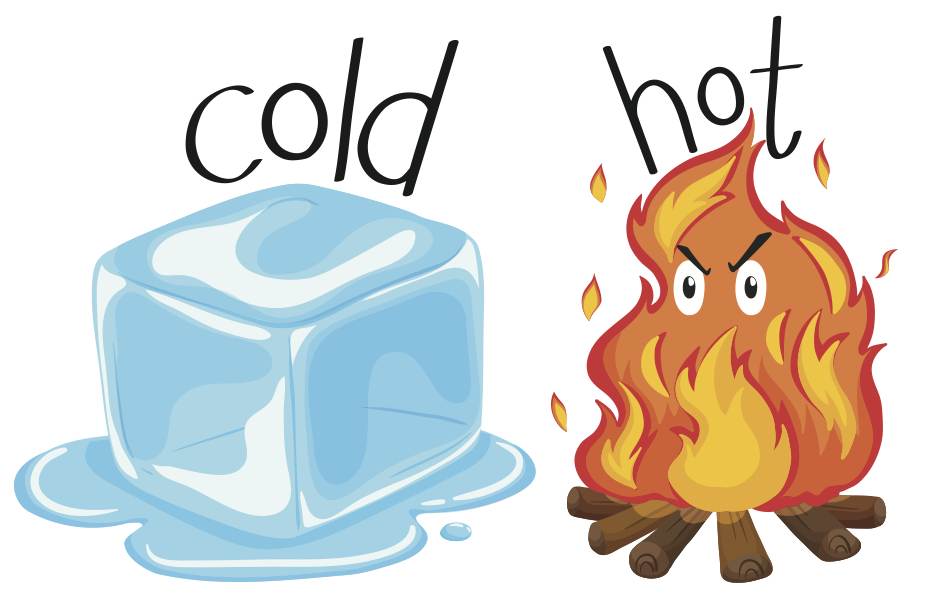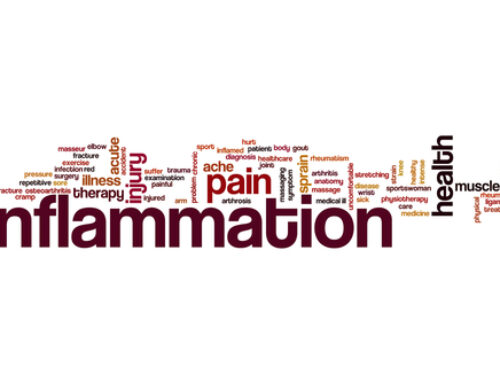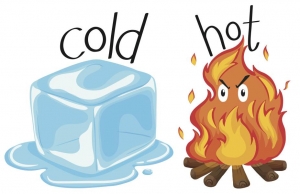
The question of “Should I use Ice or heat?” is one that chiropractors hear and answer multiple times a day. There is so much confusion about this issue, which is a shame because therapeutic icing and heating (cryotherapy and thermotherapy) are rational and cheap self-treatment options with minimal risks. Unfortunately many differing opinions, based upon differing research, cloud the specifics related to these treatments. We hope to shed some light of clarity on this important topic. When in doubt, it is important to ask a professional what therapy is appropriate for you and your condition.
“Ice is for inflammation and heat is for muscle tension,” is a good way to frame the discussion early on. Ice has the ability to calm down damaged superficial tissues that are inflamed, red, hot, and swollen. Icing is mostly just a mild, drug-less way of dulling the pain of inflammation. Examples: a fresh muscle pull, swollen ankle, or a new case of IT Band Syndrome.
Heat is for muscles, chronic pain, and stress. This takes the edge off the pain of whole muscle spasms and trigger points. It also addresses debilitating neck and back pain. Heat can make inflammation worse and the brain may interpret the excess heat as a threat and amp up pain sensitivity. So pay attention as we discuss how and when to use heat later in this article.
Ice – Why, How, and When:
Icing (“cryotherapy,” for therapy geeks) is an essential injury management skill. Individuals should understand icing the same way everyone knows how to put on a Band-Aid. It is a cheap, effective, drug-less method for relieving the pain of injuries. Safe application of ice to your skin can relieve symptoms from sprains, strains, bruises, and tendinitis, virtually any situation in which superficial tissues are inflamed by trauma. Icing could also assist recovery from repetitive strain injuries like tendinitis or IT Band Syndrome.
Does Ice slow down the natural healing process? Inflammation is indeed a normal part of healing but not everything “normal” in biology is wise and good and never needs to be controlled or treated. Regardless, icing is mostly intended to conservatively, temporarily treat the worst symptoms of inflammation, not to try to put it out like a fire. And so the whole “inflammation is healthy!” argument is mostly irrelevant, and conventional icing wisdom is perfectly sound and safe with the modest goal of pain control.
Ice is for injuries.
Ice is useful mainly where tissues are damaged and/or “inflamed.” Icing is primarily an analgesic, a pain-reliever, and not an actual treatment. That is, it doesn’t “fix” anything. It may help to resolve some chronic problems, but it’s mostly intended to simply numb painfully inflamed or other hurting tissues. The most commonly iced acute injuries are fresh injuries like ligament sprains, muscle strains, and severe bruises. Ice is also often helpful with chronic overuse or tissue fatigue injuries like carpal tunnel syndrome, tennis elbow, supraspinatus tendinitis, iliotibial band syndrome, patellofemoral pain syndrome, shin splints, and plantar fasciitis. Ice may also be useful for garden-variety “wear and tear” arthritis, and sometimes the nasty inflammatory arthritides (rheumatoid, ankylosing spondylitis).
Why Inflammation Hurts:
Classic inflammation is pretty well understood, and it’s mainly an immune system reaction. When tissue is damaged, the body responds with a complex array of chemical and neurological changes collectively known as inflammation. For instance, the capillaries widen in a big way to bring extra oxygen and nutrients to the area. They also “loosen,” becoming more permeable; to give immune system cells easy access to the injury. Most of the pain and discomfort of inflammation is due to this immune system activity. Of course, the immune system reaction is not the only reason injuries hurt. Damaged cells put out many kinds of distress signals. As with most biological processes, our comfort is not really a priority. In theory, cold slows metabolic activity, numbs nerve endings, and constricts capillaries. It limits and controls inflammation. It makes it hurt less. It helps us get through the day. And that’s an especially good thing for the common injuries, where the inflammation is largely pointless.
Ice For Chronic “inflammation”?
Do you have a chronic overuse injury? Have you battled shin splints for two years or plantar fasciitis for five? Then you know all about chronic inflammation. What’s going on in a repetitive strain injury like runner’s knee or tennis elbow, or Achilles tendinitis is not really inflammation, except perhaps in the earliest stages, but erratically painful degeneration or tissue rot. The chemistry of these situations is very different than classic inflammation, and in particular, involves relatively little immune system activity. The most obvious implication of this is that medicines intended to suppress immune system activity (the anti-inflammatories) are obviously not going to work well. And they don’t. So what of ice, then? Isn’t it the most basic of all anti-inflammatory treatments? Ice can relieve many kinds of pain temporarily by numbing nerve endings, of course. But does it do anything else?
Why:
Ice perhaps decreases nerve plasticity. Nerve plasticity is what occurs in chronic injuries where the body places more nerve endings in the affected area. It is as if it is trying to “listen” more to the pain. This nerve plasticity is also highly connected with soft-tissue scar formation, which restricts joint motion and decreases muscle strength. These common chronic changes respond well to direct icing and can perhaps start to reverse the additional nerve endings that have been produced in the painful area. Icing combined with soft-tissue treatments, like Active Release Technique, would be your best chance for healing.
How: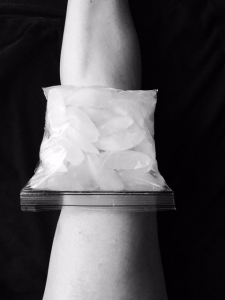
An excellent method of therapeutic icing is to use bare or “raw” ice (ice applied directly to the skin, with little to no layer of plastic or fabric between you and your ice.) Raw ice delivers more of an icy punch! This is due to the spreading of melt water into every crevice, which conducts heat more efficiently away from the skin both directly into the ice, and via evaporation. In comparison, gel packs and beanbags are comparatively wimpy psychotherapist. They tend to warm up too quickly, and they sometimes cannot shape themselves well to the contours of the injured body part. Ice in a zip lock bag is the handiest way to ice your injury. You may also want to try an ice cup.
A Styrofoam cup is an elegant delivery system for raw ice …
The humble Styrofoam cup is the cheapest and most effective injury management tool. It’s not the cup itself that’s so useful, of course, but its contents — ice! Don’t wait until you’re hurt to do this, have extra cups ready and waiting.
- Get yourself some Styrofoam cups.
- Fill a few cups with water, and freeze them.
- Cut off the top inch of the cup, exposing the ice but leaving the rest of the cup as an insulating “handle.”
Slide the ice over the inflamed area in a slow but steady pattern. It’s important to keep moving, as long as you don’t try to ice such a large area that tissue gets a chance to warm up before you return to the starting point. Continue ice massaging for 1–3 minutes, or until it is numb, whichever comes first. “When you’re numb, you’re done,” is the rule of thumb for safety. Once your tissues warm up again, you can repeat the treatment. In fact, you can apply the ice as often as you like, as long as your tissues have a chance to mostly warm up between treatments. In the case of tendonitis, you can continue doing several applications of ice throughout the day, as long as you still have symptoms, and even when you are feeling better.
Topical analgesics like BioFreeze can also be a cooling pain reliever. These safe and all natural ways to decrease pain have been used by manual medicine physicians for years. I love using BioFreeze when I cannot ice. While getting into bed, the car, going to work, or right after a game, are the perfect times to use BioFreeze.
When:
Ice is not very useful at the beginning of the day or when starting to exercise. Try using it at the end of the day or after your workout. If you are waking up in the morning sore and stiff, you probably should have iced the night before. Read the next section on how to heat stiff and sore muscles to get them moving and loose again.
Heat – Why, How, and When:
Therapeutic heating, (“thermotherapy,” for therapy geeks,) is more useful than most people realize, mainly because muscle is a source of deeper and more intense pain than most people realize. Muscle pain seems to respond well to heat. Muscle pain caused by over-exertion, muscle cramps and spasms, and especially trigger points (muscle “knots”) are all common and sometimes severe, but often mistaken for other kinds of problems.
Why – How Heat Works:
- Heat is reassuring, and reassurance is analgesic. (This is applied neurology, not just a psychological effect.)
- Heat can penetrate a few centimeters into tissue. Cells and biochemistry speed up when the tissue temperature rises, which might have therapeutic implications. For instance…
- Heat may have an effect on the common painful phenomenon known as “trigger points.”
- Heat may help soreness after exercise.
- Tiger Balm and similar products are “spicy” not warm, but they might tinker usefully with sensation: a neurological distraction.
Heat is primarily for relieving stiffness, relaxation, comfort, and reassurance. It is also helpful for taking the edge off of several kinds of body pain. Heat is most effective for duller and persistent pains associated with stiffness, cramping, and/or sensitivity, which can be loosely categorized:
- Acute soreness from over-exertion: the pain you get after the first ski trip of the season.
- Stiffness and pain in specific areas related to osteoarthritis, muscle “knots” or trigger points, and most kinds of cramping/spasm (menstrual, neuropathic, restless leg syndrome, for example, or even just stiffness from postural strain). But obviously not cramps from heat exhaustion!
- “Hurts all over” pain and sensitivity. There are many kinds, but primarily: fibromyalgia, the rheumatic diseases, drug side effects, vitamin D deficiency, and sleep deprivation.
How:
Heat has a great ability to get things moving when muscles and joints are stiff. But how you heat can make the difference between success and catastrophe. Never repeatedly use a heating pad for muscle ache and soreness. The dry heat of the heating pad can excite the nervous system and actually create an addiction like syndrome that increases the pain and feeling of the need for the heating pad. This process involves the phenomenon known as “Nerve Plasticity” where the body will place more nerve endings in the affected area as a way to listen to the pain. This process occurs in many chronically inflamed conditions such as Fibromyalgia and tendonitis. Heating pads have been observed to 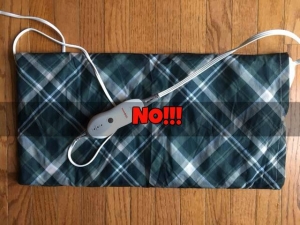 increase the speed and severity of this problem and therefore should be avoided. The only condition that heating pad may be useful would be for menstrual cramps as this is a deep cramp of a muscle and does not involve inflammation. The best way to heat a painful area is to sparingly use hot water on the affected areas. A hot shower, hot water bottle, or hot tub can provide safe and excellent relief to sore and stiff muscles.
increase the speed and severity of this problem and therefore should be avoided. The only condition that heating pad may be useful would be for menstrual cramps as this is a deep cramp of a muscle and does not involve inflammation. The best way to heat a painful area is to sparingly use hot water on the affected areas. A hot shower, hot water bottle, or hot tub can provide safe and excellent relief to sore and stiff muscles.
When:
Think of heat as a way to get things moving. In the morning sore and stiff muscles respond well to an extra long hot shower. Before a workout or the next game, a warm water bottle can bring blood flow to a stiff area and begin the process of getting loose before exertion. After a long day in the yard, getting blood flow to tired muscles to move out lactic acid is essential. This is a great time to soak in an Epsom salt bath or try using eucalyptus oil in the water to relax the fatigued areas.
Conclusion:
Ice and heat are two important and cost effective tools for helping the body heal. They are more useful than most over the counter NSAIDs and can be the safest way to self-treat. Using them at the right time is key but even if you get confused don’t worry. The human body has an amazing ability to heal itself. Occasionally, it needs a little help in the right direction. Ice and heat may be the necessary nudge.
Stop by our Roanoke, Virginia office to pick up products and schedule an appointment or call us at: 1-540-344-1055
Biofreeze 10% off this week!

Dr. Daryl Rich, DC, CSCS

